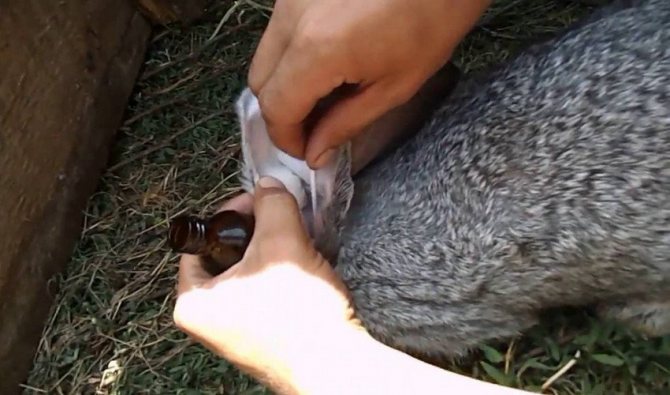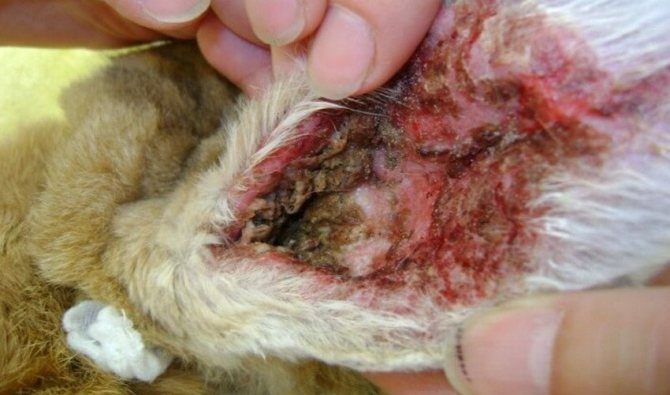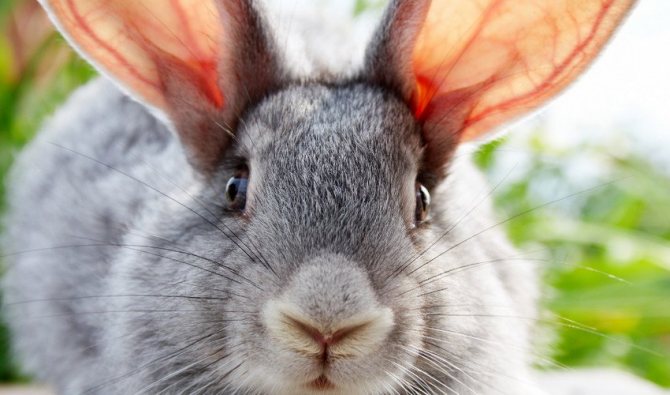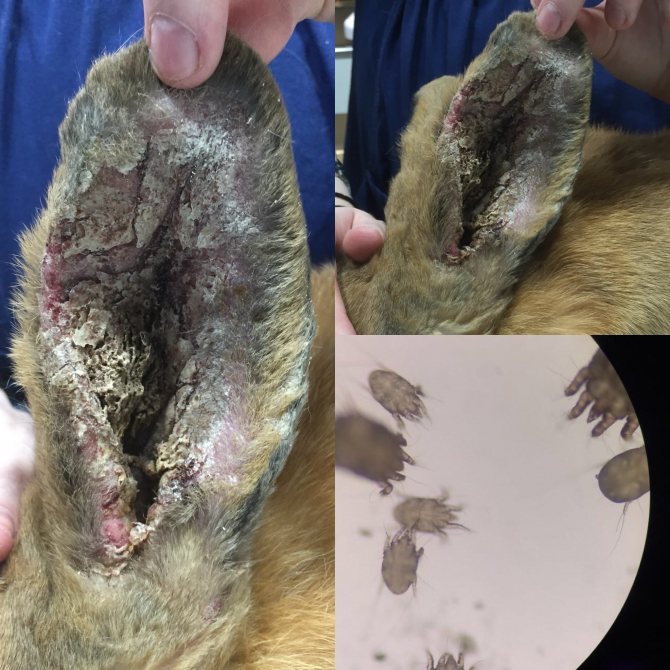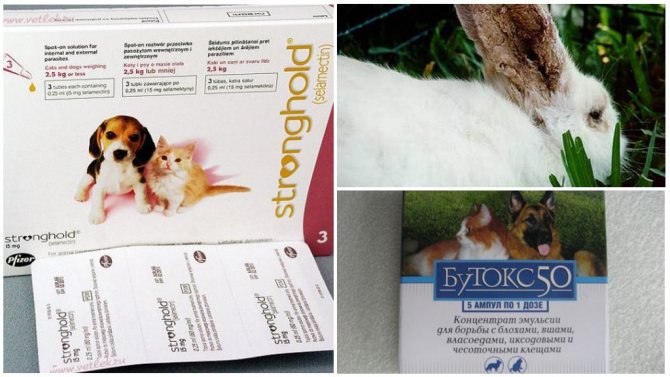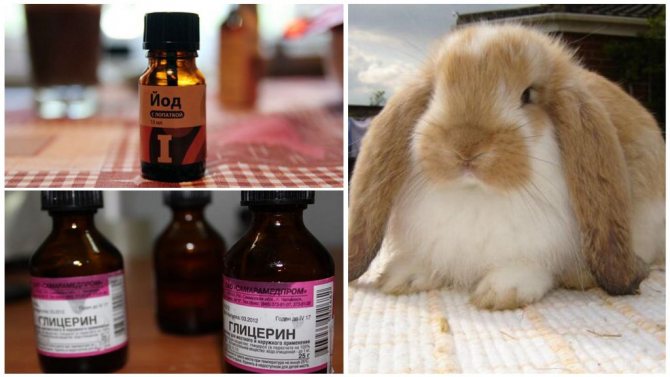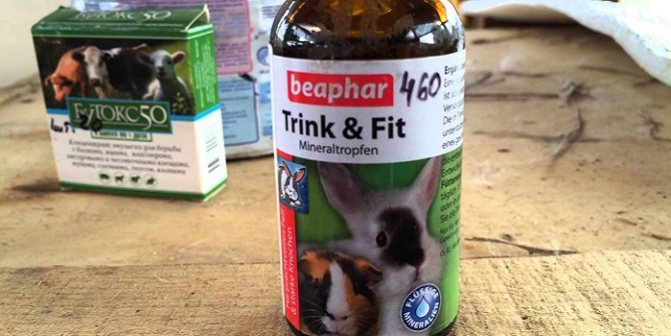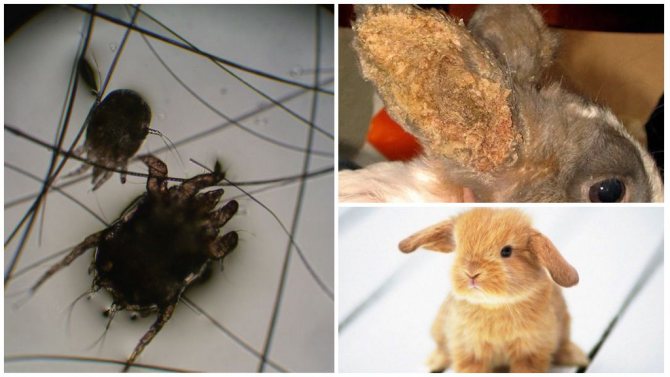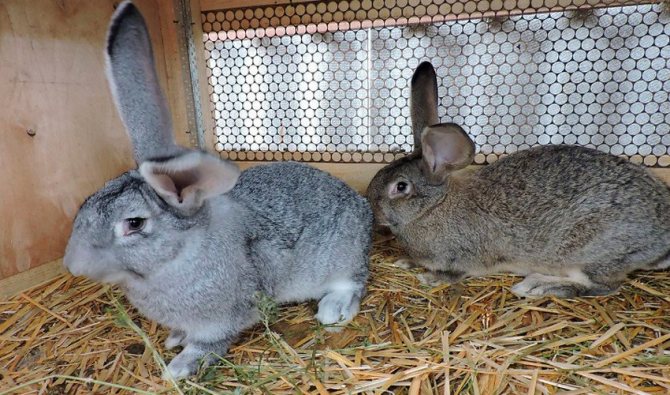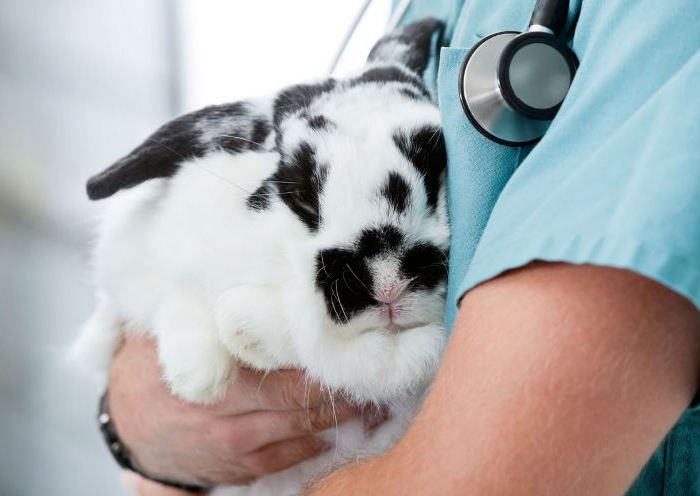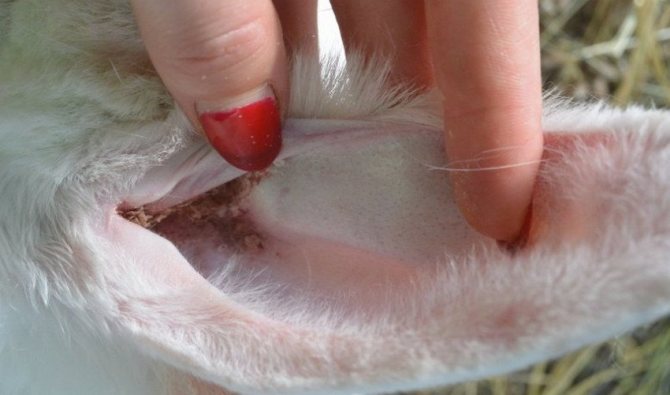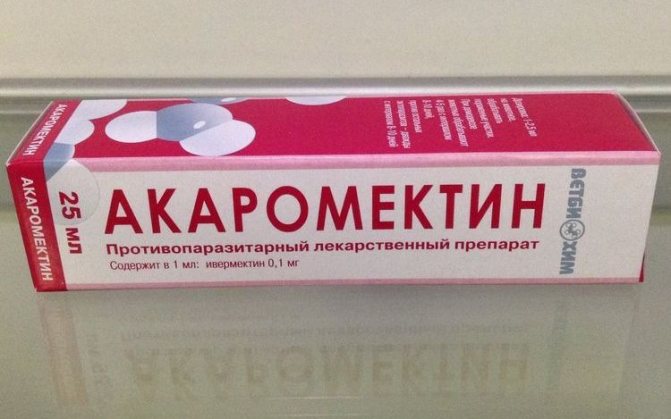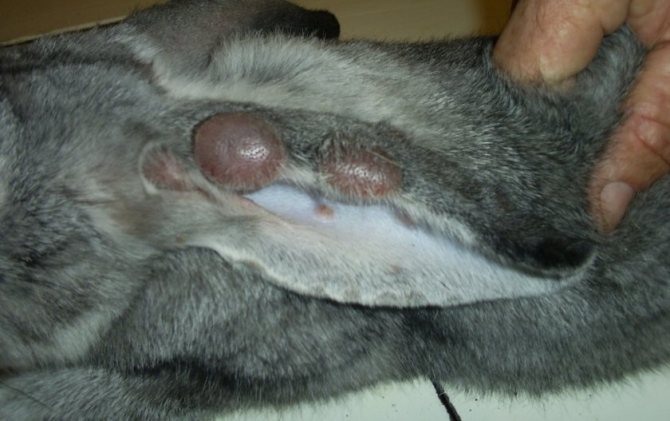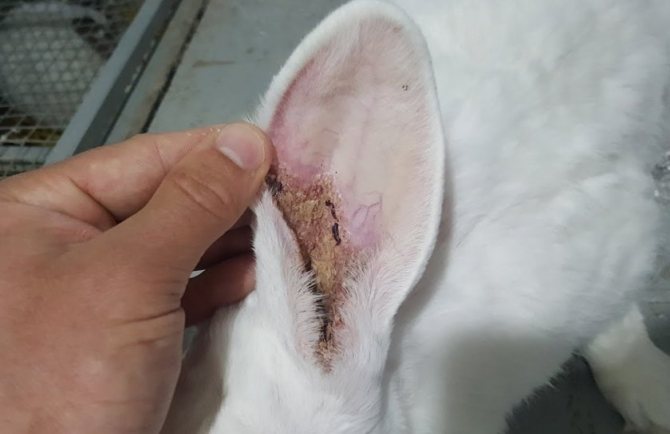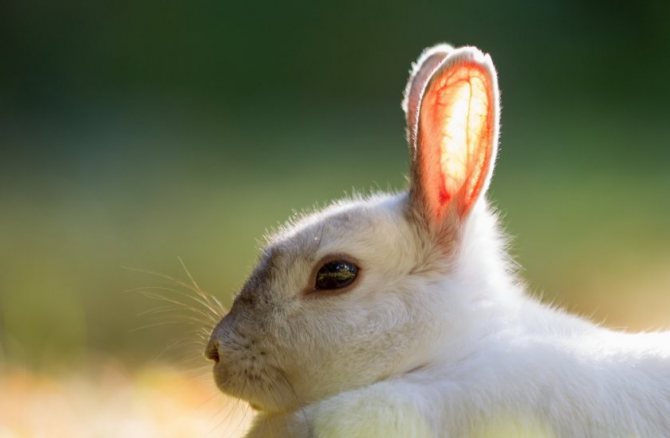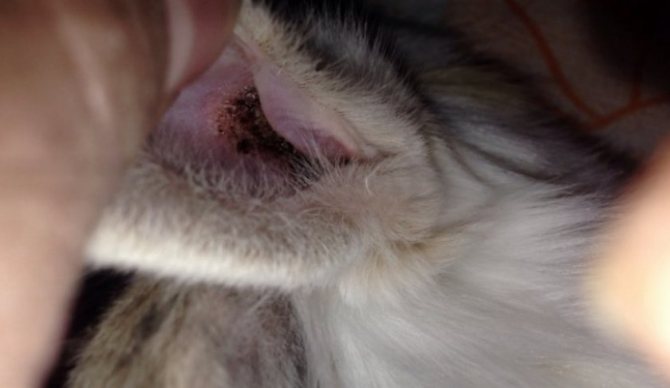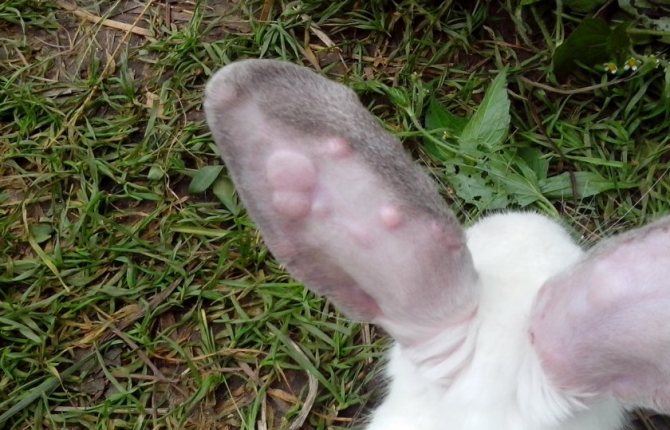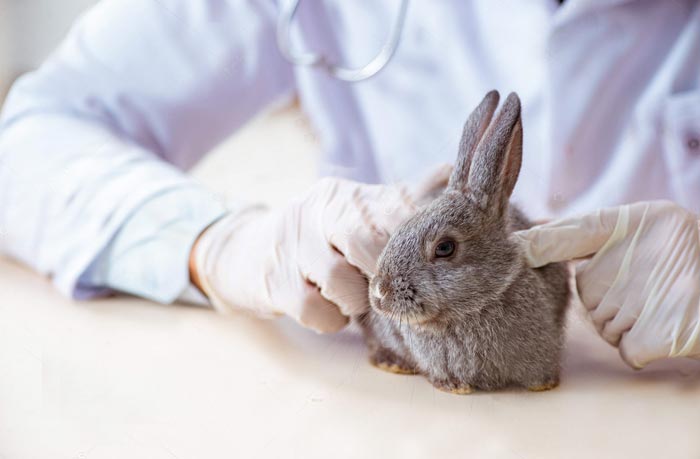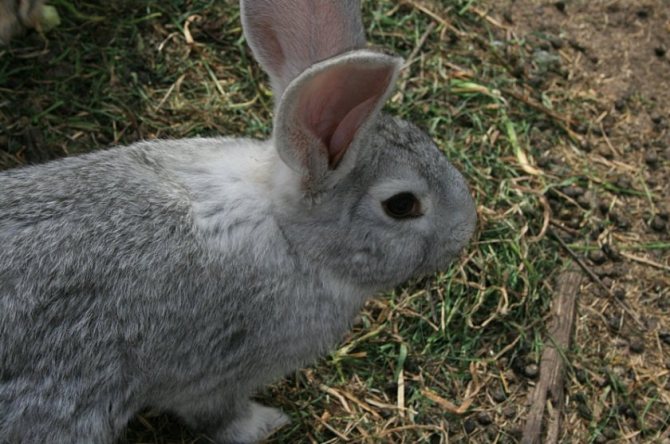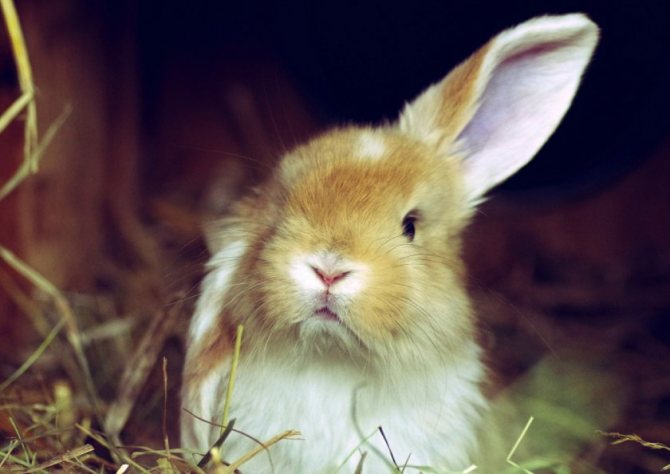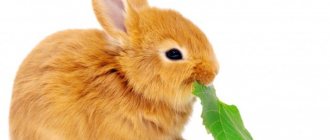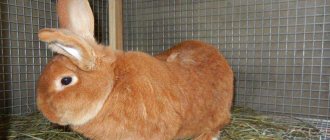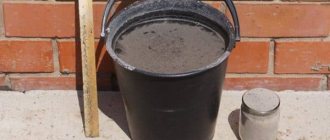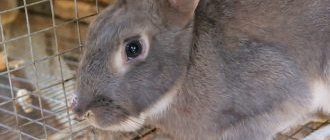Rabbit meat is tasty and healthy, doctors classify it as a dietary food group. Today, many Russians are engaged in breeding these fluffy pets. But like any living creature, a rabbit is susceptible to many diseases. Most often, such ear diseases occur in rabbits:
- ear mites or psoroptosis;
- myxomatosis;
- purulent otitis media.
There are many causes of diseases: infections, parasites, inappropriate temperature conditions. To raise a healthy population of rabbits, you need to be attentive to the pets, monitor their condition, know the symptoms of diseases, and ways to provide assistance. Most often, users type the phrase: "rabbit ears disease, symptoms and how to treat them." We will try to answer these questions in the article.

Earwax
Sulfur buildup is not a disease. Sulfur release is a common, non-pathological process. A lot of sulfur accumulates in the ear canal, and it becomes clogged. A clogged ear canal can cause other ear problems. The solution to the problem is cleansing. This must be done as carefully and affectionately as possible so that the animal does not panic. If the rabbit gets scared and starts to struggle, it can hurt itself.
How to clean your bunny ears:
- The edge of the ear is gently folded back.
- With a cotton swab, they clean the inner surface of the ear, removing accumulations of sulfur and other dirt.
- It is forbidden to push the tampon deep into the ear - you can damage the eardrum.
A healthy ear has smooth, pale pink skin. When cleaning the ears of a rabbit, they are examined along the way - if there is redness, peeling, abscesses, it is necessary to show the animal to the veterinarian.
If the ear wax gives off a strong, unpleasant odor, it is likely that parasites have settled in it.
Preventing the accumulation of earwax is simple - you need to periodically clean the ears of animals, without waiting for the formation of sulfur plugs.
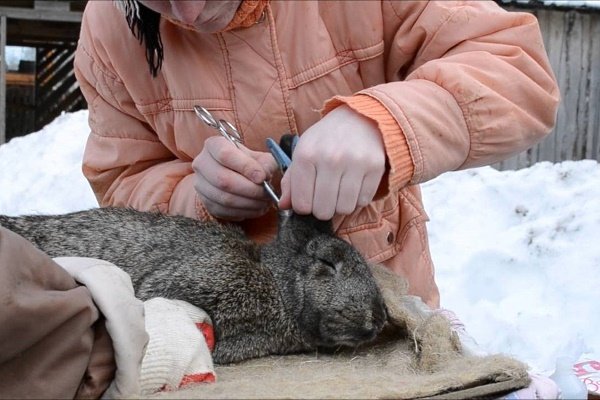

A piece of cotton wool moistened with a special lotion for cleaning the ears of animals is wound on the medical clip
Purulent otitis media
This disease at the initial stage is difficult to differentiate from psoroptosis. Moreover, the disease is generally difficult to detect - the focus of infection is located behind the tympanic membrane, therefore, it is not possible to visually see the problem.
The causes of purulent otitis media:
- hypothermia;
- head trauma;
- poor nutrition;
- fungal disease;
- accumulation of sulfur;
- insects and parasites;
- trauma to the inner surface of the ears;
- somatic weakness.
Symptoms:
- lack of appetite;
- inadequate response to touching the ears;
- when the disease worsens, purulent discharge appears in the auricle;
- with progressive otitis media, the work of the vestibular apparatus is disrupted - the animal makes strange movements, moving, as if it does not see the surrounding objects;
- the eyes are constantly moving - rotating or moving horizontally.
If you suspect or find otitis media, they contact your veterinarian to clarify what to do and what drugs to use.
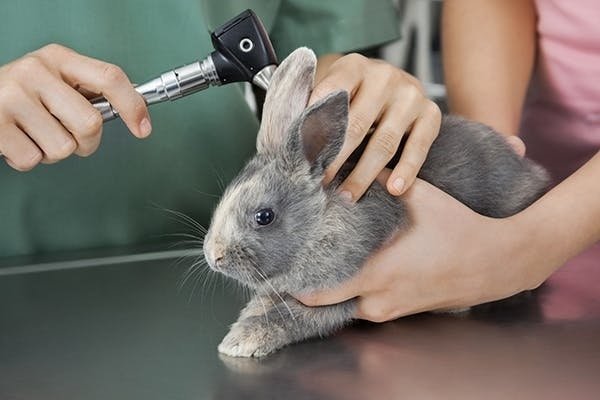

Self-medication is not allowed - if you choose the wrong drugs, the rabbit's condition may worsen. For treatment, medications are usually used in the form of drops - they are instilled into the ears to relieve pain and eliminate inflammation.
Myxomatosis
A dangerous disease in which, along with inflammatory processes, purulent conjunctivitis develops.The body of the animal becomes covered with bumps and blisters.
Symptoms that can be used to diagnose myxomatosis appear 20 days after infection. But if you carefully examine the animals every day, you can recognize the disease at the initial stage - by red spots on the skin and by seals that have appeared on the ears and eyelids.
Symptoms of progressive myxomatosis:
- The temperature jump is up to 41 degrees. But after a while it drops to normal.
- Watery eyes. The condition resembles conjunctivitis - the lower eyelids are filled with purulent clots.
- The body is covered with tumors comparable in size to a pigeon's egg.
- The head and genitals are swollen.
- The ears are drooping, the scalp is covered with folds.
- Inflammation in the mouth. Wheezing and purulent discharge appear.
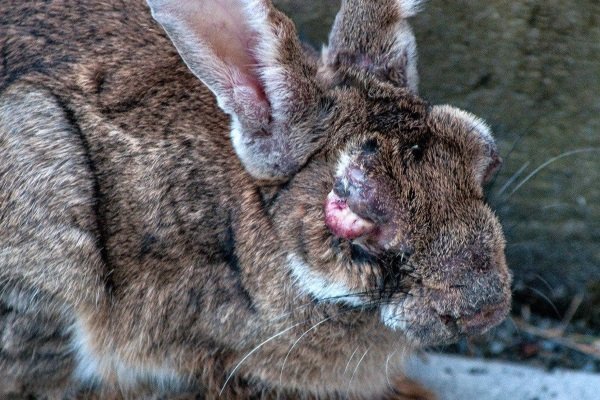

Rabbit myxomatosis
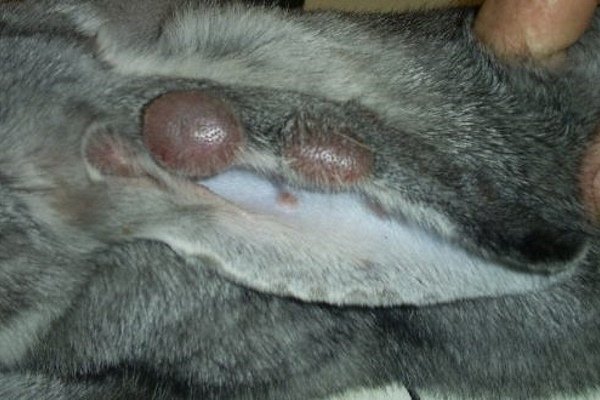

Rabbit ear tumors
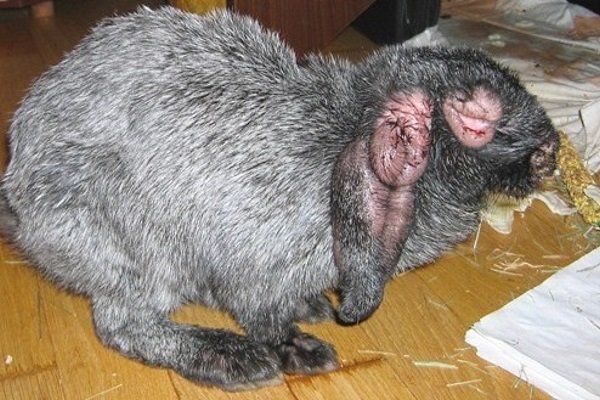

Severe myxomatosis in a rabbit
Timely and correct treatment gives a positive result. The veterinarian prescribes strong antibiotics and immunomodulators. Gamavit, Baytril or Ringer are injected subcutaneously. Drops prescribed for myxomatosis are instilled into the nasal passages, and the wounds are treated with iodine.
If you do not recognize the symptoms in time, and do not take action, one sick rabbit can provoke the death of the entire livestock.
Recovered and sick rabbits are kept in a warm room, always isolated from the herd. Rehabilitation after treatment - three months.
Many rabbit breeders treat myxomatosis, and quite successfully - with folk remedies. True, the effect occurs only at an early stage of the disease. Methods for treating myxomatosis with alternative methods:
- treatment of affected areas with overcooked sunflower oil;
- treatment of wounds on the ears with urine previously exposed to the sun for 3 hours;
- feeding with fresh horseradish leaves;
- adding pumpkin pulp and freshly squeezed pineapple juice to the feed;
- aromatherapy with eucalyptus oil;
- an injection into the shin of a solution from a camel thorn.
The breeder tells how he cured myxomatosis in his rabbits:
Hypothermia
If the ears are swollen, then they received a dose of hypothermia. You can help your pet in this situation if you rub the ears, and then bring it into a warm room.
After the ears become dry and warm, you should treat them with petroleum jelly. Camphor oil is used as an alternative. With the appearance of bubbles bursting and becoming scabby, the second stage begins.
It is necessary to open the bubbles and smear the inflamed areas. To do this, use an ointment based on camphor, zinc or iodine.
If the third stage of hypothermia has come, then the skin of the ears begins to wrinkle and dry out. The tissue cells are dead and need to be removed. The pet itself must be placed on warm straw.
Ear drop
Inexperienced rabbit breeders often do not pay attention to the alarming symptom - falling ears. Often this phenomenon has nothing to do with pathologies. But the task of the breeder is to carefully examine the auricles.
Finding the cause of falling ears:
- During the examination, they check whether there are sores or wounds in the ears, and a foreign body in the ear canal.
- It is convenient to lift rabbits by the ears, this can cause the ears to fall - during lifting, injury to the circulatory system, cartilage and nerve endings can occur.
- If the ears are healthy and no problem is found, it is possible that the ears are falling due to high ambient temperatures. This phenomenon is typical for young animals - their ears often drop in the heat.
- The falling ears may be due to the playfulness of the rabbit - perhaps he just pinned them down. Mechanical hall may also occur.
- Ears can fall off due to the presence of parasites in them.
If the ear is bent, then a supporting structure is made for it - a kind of splint. Or they glue the ear with a plaster to the second ear, which has retained its shape. If the cause of falling ears is parasitic insects, appropriate treatment is used.
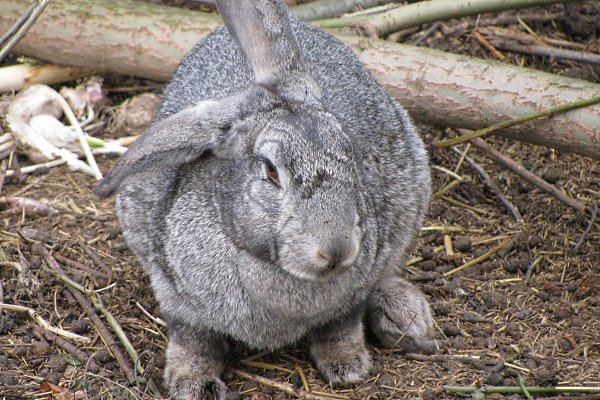

Psoroptosis (ear scabies)
The source of this infectious disease is ear mites. This insect hides in the ear canals and is difficult to spot. The incubation period is 3-5 days. If rabbits are kept in cages, the disease becomes widespread. Usually the epidemic rages in winter and spring.
Causes of ear scabies:
- Infection occurs when sulfur falls out of the ears of a sick animal, or when it comes into contact with dandruff.
- Equipment and other items that were used when caring for a sick animal and were not disinfected.
- Scabies can be transferred from sick rabbits to healthy ones by people caring for them.
Symptoms:
- Anxiety, animals rub their ears with their paws, shake their heads.
- In mild forms, inflammation develops, resembling weeping eczema.
- On the inner surfaces of the ears, there are red swellings that eventually become bubbles. The latter burst, a yellow liquid flows out, it dries up, turning into crusts. The ear canal is clogged with lumps of sulfur.
- In severe forms, the lesions merge, there is abundant discharge of sulfur and pus. The resulting crust completely closes the ear canal.
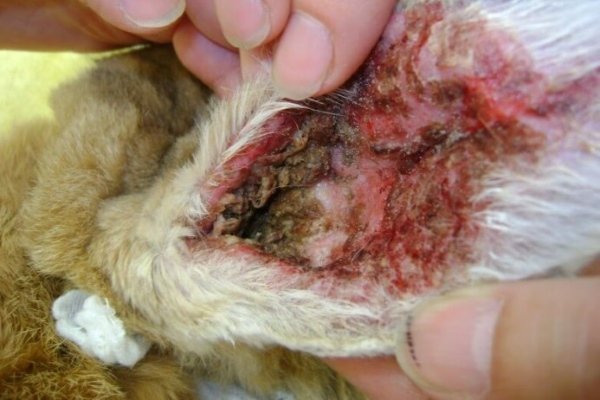

If ear scabies is not treated, the inflammation penetrates deeper - to the brain. The meninges are affected, the animal has a disorder of the central nervous system.
The diagnosis of psoroptosis becomes after examining scrapings. To identify the tick on their own, take a scraping from the ears and place it in liquid paraffin. Ticks can be seen under a magnifying glass - if any.
Treatment for psoroptosis:
- Isolation of sick animals from the herd,
- Treatment of the auricles with acaricidal sprays, foams and ointments - Psoroptol, Tsiodrin, Akrodeks, Dikresil. Processing is done once a week until the ticks are completely eliminated.
- Injections for general therapy are injected subcutaneously - Baymek, Ivomek.
Preventive measures:
- Antiparasitic treatment of aviaries. Cleaning is carried out once every half a month - at least. Disinfect tools and equipment.
- Keeping new animals in quarantine - for a month. During this time, newly purchased rabbits are examined several times for the presence of ear scabies.
- Each animal is periodically examined for the presence of parasites. The minimum frequency of inspections is once a month.
- To avoid contamination of young animals, pregnant females are carefully examined a couple of weeks before birth. Preventive treatment of the ears is carried out.
How to treat ear mites in rabbits is described in the video below:
Drug treatment
How to feed a decorative rabbit
At the first signs of the development of the disease, the animal must be immediately quarantined. The next step is to consult a specialist. It is important to recognize the disease in a timely manner and begin treatment.
A specialist can examine a sick pet at home.
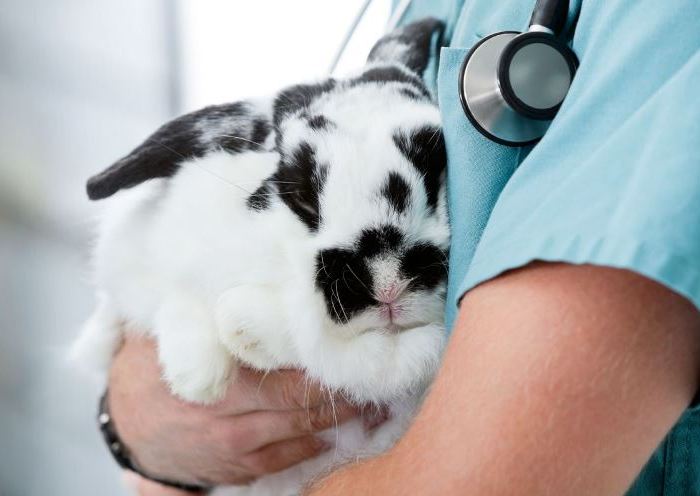

Examination by a specialist
To identify a tick, you need petroleum jelly, a scraping tool, glass and a magnifying glass. Vaseline is heated to 40 degrees, and then a scraping is placed in it. The resulting sample is placed on glass and examined under a magnifying glass - usually swarming of ticks is clearly visible. This method is suitable if it is not possible to take the pet out for laboratory analysis.
Rabbit ears have scabs - how to treat? They approach the destruction of an ear mite in a complex way, using drugs of general and local effects. It is good to use medications in the form of foam and aerosol in the fight against psoroptosis:
- Acrodex;
- Psoroptol;
- Dikresil;
- Cyodrin;
- Acaromectin.
The drug is sprayed on the affected areas 2-3 times a day, for 5-7 days.The course of treatment is repeated after 7 days.
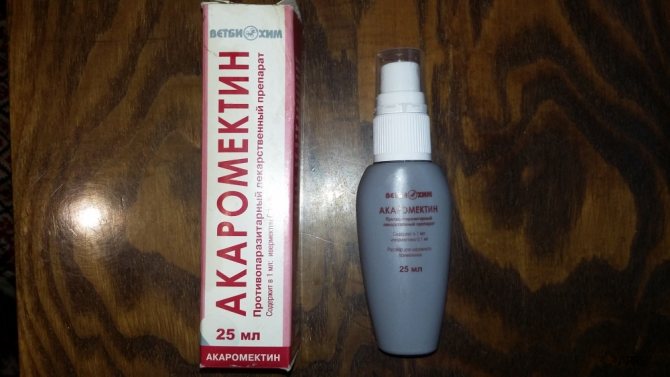

The drug "Acaromectin"
For the treatment of infections, Baymek or 1% Ivomek solution is used. The drugs are administered with the help of injections, the dose for each animal is individual and is calculated based on its body weight.
The effectiveness of such treatment is that the drugs kill not only adult parasites, but also the larvae. The pet often feels better after a couple of days. The drug Dekta also showed itself well - it not only destroys parasites, but also reduces inflammatory processes.
Veterinarians do not recommend treating purulent otitis media at home. Several types of bacteria can cause the disease at once, therefore, before starting treatment, it is necessary to identify the pathogens and select the appropriate drugs. The most effective antibiotics for otitis media are Prednazolone and Albendazole, the doctor calculates the required dosage.
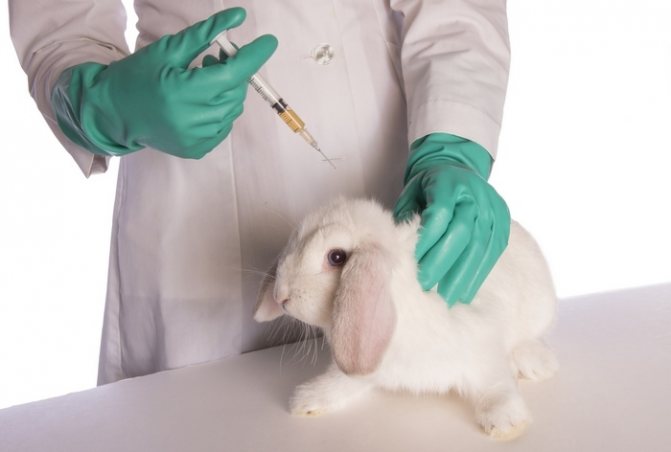

Rabbit treatment
For frostbite of the ears, use Alyusprey. The medicine is available in the form of a spray, which simplifies the procedure for its application. The drug is used after processing frostbite areas: removing hair, secretions and dried epithelium.
Attention! It is forbidden to treat the ears of the herbivore with alcohol, as well as iodine and brilliant green. Alcohol solutions can burn the delicate tissues of the auditory organs.
Why is it important to start timely treatment? If the ears are affected, coordination of movements may be impaired. The animal may die due to the development of complications and the penetration of infection into the brain. Usually, a herbivore can be cured of ear scabies within a week.
Frostbite
The ears of rabbits are quite delicate, when they are in cold rooms, they are the first to suffer. Frostbite is caused by low temperatures.
The symptoms of frostbite are easy to spot:
- The ears become cold and swollen. Touching the ears hurts the animal - this is the first degree of frostbite.
- With the second degree of frostbite, blisters appear on the ears, which, bursting, form purulent ulcers. The skin, drying and flaking, becomes covered with open wounds;
- The third degree of frostbite is accompanied by severe pain and death of the affected tissue.
The affected animal is transferred to heat. With the 1st degree of frostbite, the affected areas are lubricated with fat - pork or goose. At the 2nd degree, camphor or iodine ointment is used for treatment. With the 3rd degree, you cannot do without the help of a veterinarian. The dead areas will have to be removed, and the wounds that are formed in this case are treated in the usual way.
The breeder shows a rabbit with frostbite ears:
To prevent frostbite of the ears, the cages are insulated with straw mats - on especially frosty days they cover the aviaries from the side of the barred walls. Straw is thrown into the cages so that the rabbits hide in it in the cold.
Folk remedies
With psoroptosis, it is possible to reduce itching and get rid of the tick by treating the affected areas with a solution of turpentine, creolin, kerosene and sunflower oil or glycerin, the mixture is made at the rate of 1: 1. To apply the product, a disposable syringe is used, from which the needle is first removed.
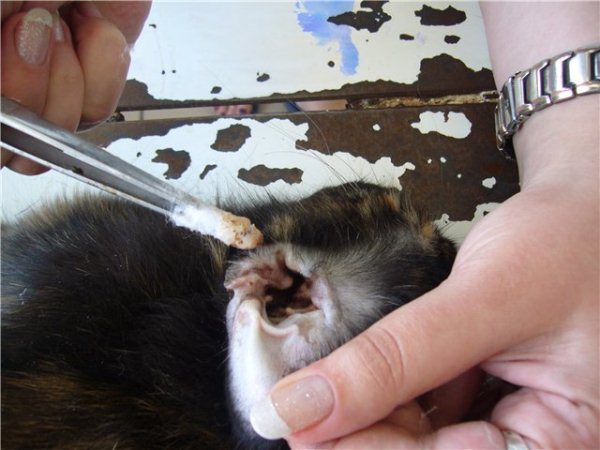

Home treatment for rabbit ears
Then the ears of the rabbit are massaged and the crusts are removed. Before removing a particularly large crust, the crusts are softened with glycerin and iodine, the mixture is made at the rate of 4: 1. The solution can be applied to damaged areas every other day.
On a note! For frostbite use goose or pork fat. The affected areas are coated with salt-free fat. In case of severe damage, dry areas are treated with 1% camphor ointment.
Cold ears
Rabbit ears are a kind of indicator of well-being. Body temperature is strongly influenced by fluctuations in atmospheric temperature. To maintain its own body temperature, the rabbit often does not have enough heat from the skin and subcutaneous fat.The animal loses a lot of heat through the ears. They are cooled if there is weak venous blood flow in the capillaries of the vessels.
Cold ears can be caused by:
- Reflex compression (spasm) of capillaries due to frost.
- Low blood pressure.
- Stress, fear.
If the animal is doing well, you can ignore the cold ears. But if the air temperature drops below minus 15 ° C, it is necessary to take measures - to insulate the cells, to eliminate drafts. Cold ears are not an important diagnostic feature. They usually indicate frostbite.
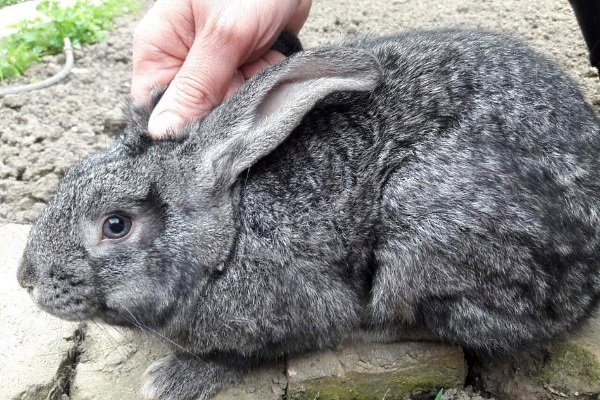

Disease prevention
Preventive measures when keeping rabbits must be strictly followed. Treatment of ear diseases is often time-consuming and costly, and is inconvenient for both you and the animals. To avoid this, follow these simple rules:
- vaccination of rabbits against myxomatosis at the age of 45 days (pregnant rabbits can be vaccinated);
- regular inspection of individuals;
- cleaning your ears from dirt and wax;
- disinfection of feeders, drinkers, bedding, cages at least once a month;
- warming the cells with straw and transferring them to an insulated room during the cold season;
- placement of cells in the shade and in a ventilated place during the warm season;
- compliance with quarantine 2 weeks for newly purchased rabbits;
- a diet of high-quality and nutritious food;
- regular cleaning of cages - they must be clean and dry.
Sick rabbits are separated from the rest and returned only after complete recovery.
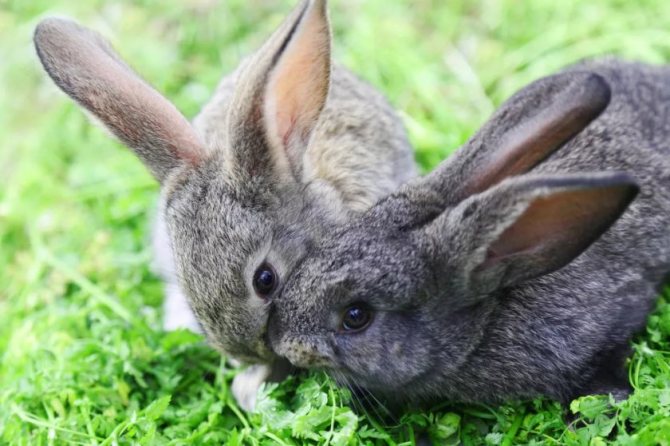

Due to ear diseases, which are ignored by owners, animals often die, endangering the entire population of rabbits. Timely measures and prevention of diseases reduce the risk of death to a minimum or eliminate it altogether.
«>
Hot ears symptom
Rabbits, like many animals, do not sweat. Their heat exchange occurs along the capillary network of the ears. If your rabbit's ears are hot and is feeling normal, it is most likely just hot.
What hot ears are talking about:
- Signs indicating a normal condition:
- Animals have a normal appetite. They drink as usual.
- The inner surface of the auricles is pink or red.
- There is an adequate response to any stimuli - to touch, sound, etc.
- When light enters the eyes, the pupils narrow, in the dark they dilate.
- Urination and stool separation are normal.
- Signs that signal health problems:
- The animal is lethargic, mostly lies, does not eat, swears, coughs, has snot, etc.
- The inner surface of the ears is pale or bluish.
- No response to loud and harsh noise. If there is no reaction to pain, it is possible that a painful shock has occurred.
- Shock, collapse and coma are also indicated by the lack of reaction of the pupil to light.
Ear bleeding
Rabbit ears have a complex vascular system. As soon as the ear is scratched, profuse bleeding begins. If blood has flowed, the ear is wiped with a cotton swab moistened with hydrogen peroxide. In this way, blood is removed from the skin, and the exact location of the damage is determined - wounds or scratches.
The cause of ear damage and, as a result, its bleeding is often the usual scratching - rabbits tend to scratch their ears, which leads to their damage. They scratch their ears due to an allergic reaction or the presence of parasites.
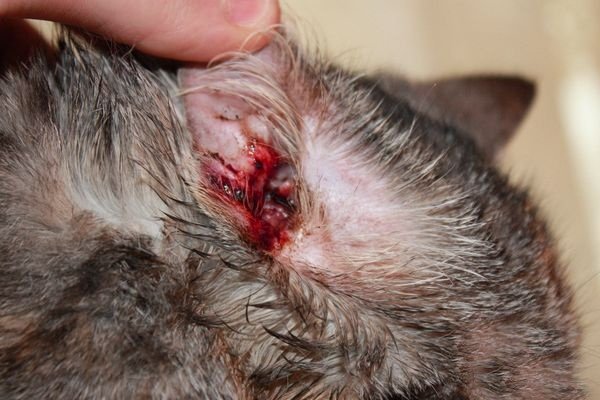

Rabbit ears are one of the most vulnerable spots. Thanks to simple prevention, vigilant examination and timely diagnosis, serious illnesses can be avoided. If, nevertheless, the animals become ill, competent treatment is necessary - it will prevent complications caused by ear diseases and the premature death of the livestock.
0
Why is ear mite dangerous in rabbits and how to deal with it at home
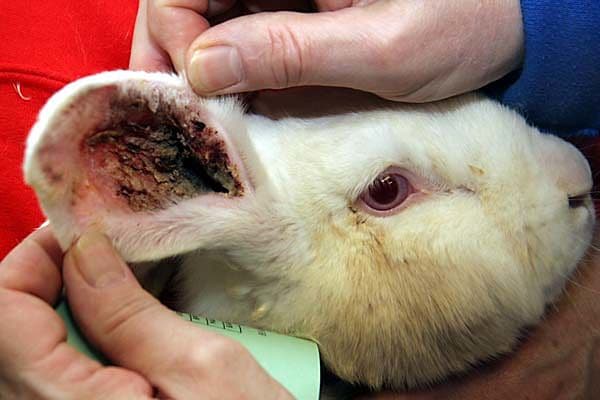

Rabbits can be subject to a wide variety of diseases. They are vulnerable to small parasites.
Ear scabies is a fairly common disease that often occurs in rabbits.The causative agent is an oval itch mite. This disease is called psoroptosis. It progresses rapidly and therefore it is important to detect the parasite as early as possible.

